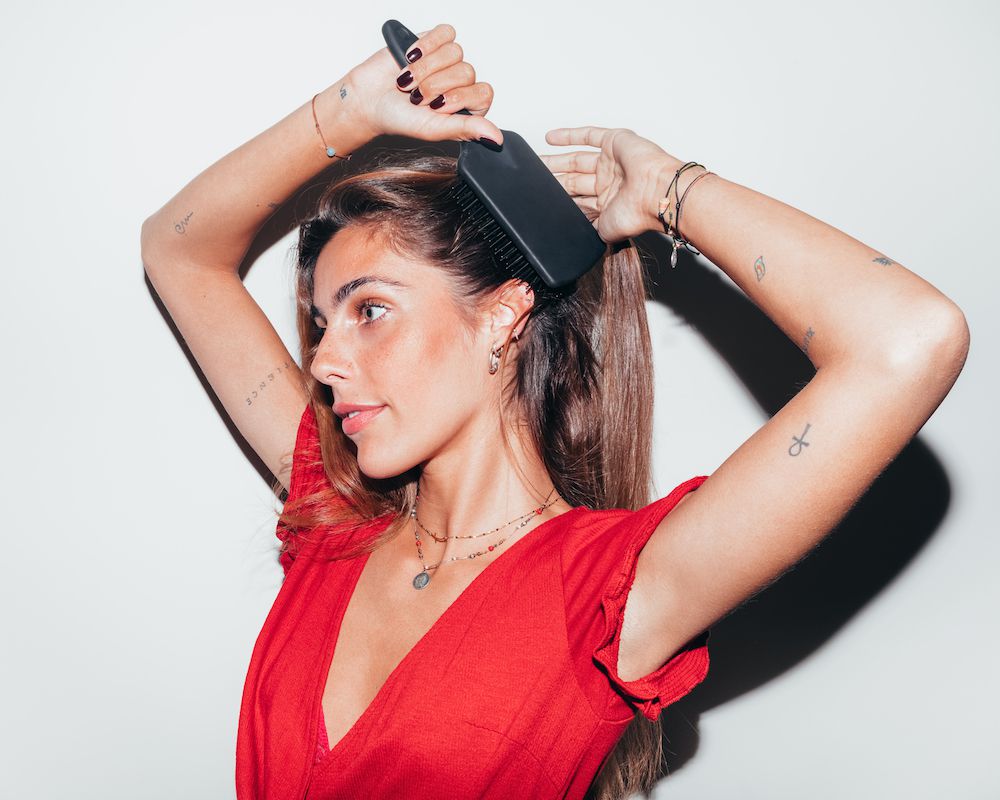Picture this: You’ve just finished a sweaty home workout but don’t have time to refresh your hair in the shower. You open your cabinet to reach for your favorite dry shampoo only to find that it’s returning empty spritzes.
Without any product, what’s a person to do? Fall back on a tried-and-true dry shampoo alternative, of course. As you likely know, dry shampoo hasn’t been around forever. Greasy hair, on the other hand, has. As such, people all over the world have experimented with common pantry items, beauty products, and styling techniques to make oily roots look noticeably less shiny.
So, if you ever find yourself without your beloved dry shampoo, don’t panic. We reached out to the experts—including board-certified dermatologist Dendy Engelman, MD, and hairstylists Kelly Harrison, Adam Campbell, and Marcia Lee—for their picks for dry shampoo alternatives. Keep reading for what they had to say.
Meet the Expert
- Dendy Engelman, MD, is a board-certified cosmetic dermatologist and Mohs surgeon based in New York City.
- Kelly Harrison is a hairstylist and brand manager for BIOTOP Professional.
- Adam Campbell is a celebrity hairstylist. His clients include Angelina Jolie, Liv Tyler, and Natalie Portman.
- Marcia Lee is a celebrity hairstylist whose clients include Jodie Turner-Smith and Natasha Lyonne.
01
of 10
Corn Starch
No dry shampoo? No problem. Chances are if you peek in your pantry, you’ll find a canister of corn starch. “Corn starch is a common household item that is safe and absorptive to use as a dry shampoo alternative,” says Engelman. “You can apply a small amount of this to your hairline by hand or with a contour brush, and for those with darker hair, it can be mixed with cocoa powder if you’re worried about leaving a residue.” In addition to eliminating greasy roots, she says that corn starch is odorless, too, so you won’t feel like you’re being followed by a cloud of fragrance all day.
One thing to note: If you’re particular about the products you use, Harrison points out that corn starch can include GMOs. “Even though it’s being used in your hair and not ingested, if avoiding GMOs is important to you, you’ll want to check,” she says.
02
of 10
Baking Soda
Building on corn starch, Campbell says that mixing the ingredient with baking soda is another way to diminish oily roots. “In a bowl, combine equal parts baking soda and cornstarch with a few drops of essential oil (lavender, tea tree, peppermint, etc.),” he suggests, recommending tablespoon measurements. Once mixed, he says to sprinkle the concoction lightly onto the scalp. “Allow it to sit for a few minutes to absorb excess oils and then shake out excess,” he says. The one downside? He admits that this mixture can sometimes leave a whiteish residue on darker hair colors. “It’s really only to be used in a pinch,” he adds.
That said, if you find you really enjoy the results, Lee recommends keeping a salt shaker of corn starch and baking soda at the ready. Furthermore, for an even more refreshed head of hair, she says that using a hair dryer on the cool setting with a soft bristle brush can help to really work the product in, blow away any excess, and add volume in the process.
03
of 10
Baby Powder
An oldie but a goodie, “baby powder is known as being a reliable dry shampoo alternative, as it was used before dry shampoos were popular,” Engelman says. For the best results, she and Harrison both remind us that less is more. “Applying a teaspoon of baby powder and then brushing it through your hair will absorb the excess oil and leave your hair looking fresher than before,” Engelman says. Don’t just sprinkle it in on top of your part, though. Instead, Harrison says to section your hair and apply the baby powder lightly between the layers to absorb throughout, as opposed to solely on top.
When considering baby powder for your quick hair fix, just remember that, unlike corn starch, it does have a slight scent. What’s more, Harrison says that baby powder tends to work best on blonde hair, given the white color of the product. “It also works best on thicker hair, because if too much is applied, it can leave fine hair looking limp and lifeless,” she adds.
From a health stance, Harrison points out that most baby powders are formulated with talc, which can be harmful if ingested. If you’re someone with a talc allergy or aversion to it, she recommends reading the ingredients label on your powder before adding it to your cart.
04
of 10
Arrowroot Powder
“Arrowroot powder is a natural starch that is often used as a thickening agent in foods, so it’s great for absorbing oils,” Engelman says. “It’s also super lightweight, which leaves a nice feeling on the hair.” That said she admits that it can be messy, so to tame it down, it’s best applied with a brush and then massaged in for the full effect.
05
of 10
Translucent Setting Powder
Although you may not want to waste your precious face setting powder on your hair, hair color specialist Seamus McKernan says it works in a jiff. “Translucent setting powder can be a great solution on the go,” he says. “Make sure you apply with a clean blush brush and tap it in rather than brushing it across to allow it to absorb excess oil. After applying, brush through to get rid of the excess powder.”
Before trying out this tip, a warning: While many hairstylists and dermatologists promote powders and starches for oil absorption, trichologist Gretchen Friese points out that these products can get cakey and cause build-up. As such, they should be used sparingly and followed up by a clarifying shampoo rinse when it’s time to hop in the shower. (Psst: R+Co co-founder and creative director Howard McLaren says that it’s actually because of the potential to cake that modern aerosol dry shampoos were created.)
06
of 10
Blotting Papers
Another makeup product that can work well for oily roots (and especially bangs) is blotting papers. “Usually used to dab up oil on the face, blotting papers can actually be used on the hair as well,” Engelman says. “These are great because they’re small and can be carried around anywhere. All you have to do is take one sheet and blot the top of your head where you see oil residue lingering, leaving a drier appearance.”
07
of 10
Apple Cider Vinegar
Apple cider vinegar is a popular skincare ingredient thanks to the way it helps regulate oil production, and Engelman says that the product can work well for greasy hair, too. “Mixing a few drops of apple cider vinegar in a spray bottle with water and spritzing it onto your hair will work wonders,” she says. “This trick is especially good because it doesn’t leave any residue like other dry shampoos or alternatives usually do.”
08
of 10
A Different Hairstyle
If you’ve been on TikTok lately, you know that not all dry shampoo alternatives come down to products. One of the best things you can do when you don’t have dry shampoo is to switch up your hairstyle. “A sleek bun or braids not only gives you a fun and low-maintenance style, but it can also hide oil on the scalp and hair,” says Harrison. On the other hand, if you like accessorizing, she says that wearing a large headband can also help draw attention away from an oily scalp.
09
of 10
Extra Texture
Not a fan of a sleek bun or simply not in the mood for one? Harrison says that teasing and back-combing your hair are other quick and easy ways to disguise oily strands. “Not only do they help create volume, but they also disburse oil and help lift your hair up from the root, making it harder to see the oils on the scalp,” she explains. “This is a great option for that updo-style event. Dirty hair always seems to style better, so tease away, and then comb it into your desired style.”
10
of 10
Other Hairstyling Products
Of course, if you’re not one to DIY your haircare, there’s always the option of reaching for a different type of styling product. While McKernan recommends hairspray (specifically Nioxin’s Niospray Strong Hold Hairspray, $18) for its oil-absorbing alcohol content, celebrity hairstylist Andrew Fitzsimons suggests reaching for a texturizing spray, like the Andrew Fitzsimons Apres Sexe Texture Spray ($14), to repurpose oily tresses.
Wish you had time to shower because nothing fully compares? Campbell suggests the Unsubscribe No-Rinse Hair Wash ($24). “It’s great for people who work out a lot,” he says, noting that all you need is two to four pumps, which can then be air-dried or blow-dried. “It’s a cleansing foam that has enzymes that combat odors and also strengthen the hair.”
Another option? A hair refreshing water like Kristin Ess’ The One Signature Hair Water ($11) can dampen your strands so that they’re easy to re-heat style. When doing so, Fitzsimons recommends reaching for the Style Assist Blow Dry Mist ($15) and Dry Finish Working Texture Spray ($14), also by Kristin Ess, to really take your oily hairstyle to new heights. “The best thing about these products is that they… work for virtually every hair type while working simultaneously to provide just the right tool to what each hair type is looking for, whether it’s shine, volume, or texture,” he says.
The Final Takeaway
At the end of the day, greasy roots happen to everyone, and it’s not something to be ashamed of or embarrassed about. “Embrace what is natural human development,” Lee says of scalp sebum. “We need this to protect and hydrate the hair and scalp. So take that time to experiment with your [hair].”
And when wash day finally arrives, Friese suggests implementing a clarifying wash—especially if you’ve heavily relied on dry shampoo alternatives (or the real deal). When doing so, she says to prioritize products that are highly absorbing, like those infused with charcoal or the BosleyMD Anti Dandruff Shampoo ($28). “It removes oils and product buildup from the hair and scalp without stripping or drying out the hair,” she explains.










